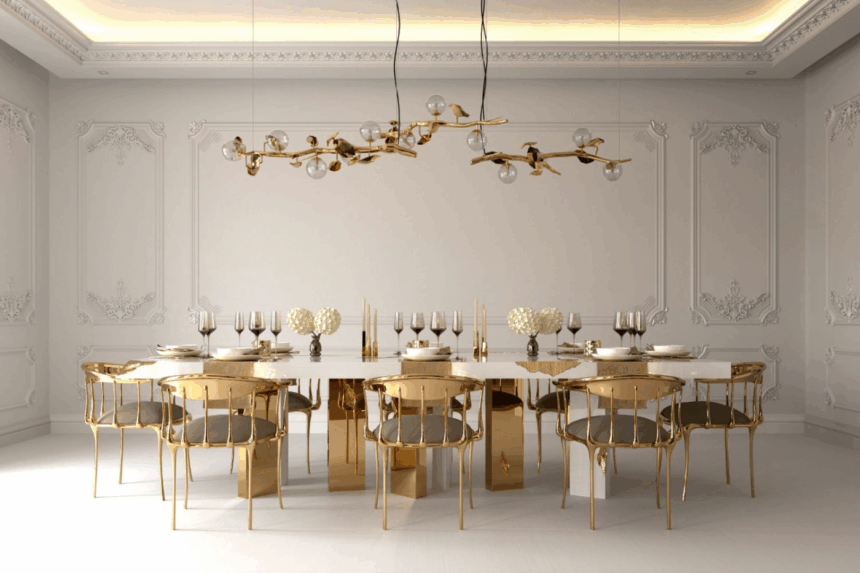The dining area has evolved from a mere space for meals to a central hub for family gatherings, celebrations, and intimate conversations. Crafting a dining space that is both functional and aesthetically pleasing requires thoughtful architectural planning. Below are nine expert-backed tips to help you design a dining area that seamlessly blends form and function.
Design Tips for an Inviting Dining Space
Picture Courtesy- Hommes Studio
Designing a dining area goes beyond selecting the right furniture and décor; it involves careful consideration of architectural elements that enhance both functionality and aesthetics. The following tips provide guidance on creating a dining space that is both practical and visually appealing.
1. Prioritise Spatial Planning
Picture Courtesy- Decor pot
Effective spatial planning is the cornerstone of any successful dining area design. Begin by assessing the room’s dimensions and determining the optimal placement for the dining table. Ensure there is ample circulation space around the table to allow for comfortable movement and seating. In open-plan layouts, consider how the dining area interacts with adjacent spaces to maintain a harmonious flow.
2. Select Appropriate Flooring Materials
Picture Courtesy- Magic Bricks
The choice of flooring material significantly impacts the dining area’s functionality and aesthetic. Opt for materials that are durable, easy to clean, and complement the overall design theme. Hardwood, engineered wood, and quality vinyl are popular choices due to their resilience and timeless appeal. Incorporating area rugs can add warmth and define the dining space, especially in larger or open-concept areas.
3. Incorporate Layered Lighting
Picture Courtesy- Ankur Lighting
Lighting plays a pivotal role in setting the mood and functionality of the dining area. Implement a layered lighting scheme that includes ambient, task, and accent lighting. Pendant lights or chandeliers above the dining table provide focused illumination, while wall sconces and recessed lighting can enhance the overall ambiance. Dimmable options offer flexibility to adjust the lighting according to the occasion.
4. Embrace Architectural Features
Picture Courtesy- iStock
Integrating architectural elements can elevate the dining area’s design. Consider adding crown moulding, wainscoting, or exposed beams to introduce texture and visual interest. Feature walls with distinctive materials like stone, brick, or textured paint can serve as focal points, adding character and depth to the space.
5. Choose a Statement Dining Table
Picture Courtesy- Boca do Lobo
The dining table often serves as the room’s focal point. Select a table that complements the room’s scale and design aesthetic. Materials such as solid wood, marble, or glass can make a bold statement. Ensure the table size accommodates the intended number of diners comfortably, allowing for easy movement and access.
6. Optimise Seating Arrangements
Picture Courtesy- House Beautiful
Comfortable and functional seating is essential for a successful dining experience. Choose chairs that offer adequate support and align with the table’s design. Mixing different styles or materials can add visual interest, but ensure cohesion through colour or design elements. In larger spaces, incorporating benches or built-in seating can provide additional flexibility and seating capacity.
7. Utilise Natural Light
Picture Courtesy- Deconovo
Maximising natural light can make the dining area feel more inviting and spacious. Position the dining table near windows or glass doors to take advantage of daylight. Use light, airy window treatments to allow sunlight to filter through while maintaining privacy. Incorporating reflective surfaces like mirrors can help distribute natural light throughout the space.
8. Integrate Functional Storage Solutions
Picture Courtesy- Livspace
Adequate storage is crucial in maintaining an organised dining area. Incorporate cabinetry, sideboards, or built-in shelving to store dining essentials such as dinnerware, linens, and serving pieces. Design these elements to blend seamlessly with the room’s architecture, ensuring they are both accessible and unobtrusive.
9. Define the Space with Colour and Texture
Picture Courtesy- Tapeko
Colour and texture choices can significantly influence the dining area’s atmosphere. Opt for a colour palette that complements the overall design theme and evokes the desired mood. Incorporate textures through materials like upholstered chairs, woven rugs, or textured wall finishes to add depth and interest. Accent pieces such as artwork or decorative objects can further personalise the space.
Designing a Dining Area That Reflects Your Style
Picture Courtesy- Design Cafe
Designing a dining area that is both functional and visually appealing requires careful consideration of architectural elements, layout, and materials. By prioritising spatial planning, selecting appropriate materials, and integrating thoughtful design features, you can create a dining space that enhances the dining experience and complements the overall aesthetic of your home. Remember, a well-designed dining area not only serves as a place for meals but also fosters connection and conversation among those who gather there.

Ar. Pranjali Gandhare
Architect | Architectural Journalist | Historian






